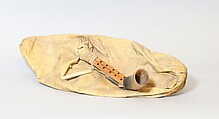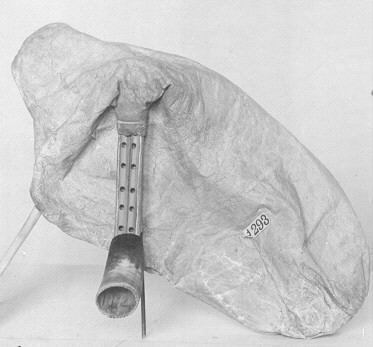Tsambouna
Not on view
The tsambouna (etymology: συμφωνία, symphony) is a bagpipe found across the Greek islands. This specific tsambouna comes from a village on the island of Naxos. It features a double melodic pipe with five fingerholes on each pipe. The melodic pipes are set in a hand-carved wooden sleeve, at the end of which an animal horn is fitted, secured to the stock by a thin strap of leather. The rim of the horn is carved into a serrated edge. Some tsambouna horns from Naxos are ornamented with beads, threaded through holes drilled into the material. The insufflation pipe is made out of a long, thin bone.
This instrument was sourced at the end of the 19th century by Louis Nicolaides, the US Vice Consul based in Athens. In December 1895, Nicolaides wrote to Brown Brothers and Co. in response to a request by Elizabeth Brown to acquire ‘a double hornpipe’. Nicolaides managed to find one ‘with great difficulty’. He paid five drachmas to the man ‘who brought it [him] from a village at Naxos’ (Nicolaides 17 December 1895, Metropolitan Museum Archives). The instrument made its way to New York in January 1896 and was included in the Musical Instrument’s 1902 Catalogue, where it was erroneously dated back to the 10th century (Metropolitan Museum 1902).
The tsambouna is traditionally played across the Greek islands, including the Dodecanese Islands, Islands from the Aegean Sea and Crete (See 89.4.855). It is either accompanied by the drum or the lyra, and is used for celebrations such as weddings, village festivities, and general entertainment. Repertoire includes dance music and songs.
While the overall organology of the tsambouna is shared across the Greek islands, instruments from different islands present differences, in particular regarding the number of fingerholes on the parallel melodic pipe. The island of Karpathos, for example, features a tsambouna with two parallel pipes: one with five finger holes, the other with only one fingerhole. As such the second pipe acts as a two-pitch drone that is used rhythmically, and accompanies the main melody. These differences led islands to develop different repertoire, which in turn feed into the uniqueness of each island’s sonic identity. Other differences pertain to the material of the horn: while Naxos favors an animal horn at the end of the melodic pipes, bagpipes from other islands present a monoxyle sleeve ending in a horn, either curved (such as in Karpathos) or straight (Crete).
(Cassandre Balosso-Bardin, 2023)
Technical description
Cane double chanter with cylindrical bores, 140 mm (set in wooden sleeve) with tied-on serrated horn bell (250 mm including bell and integral stock);
Fingerholes: R 5/0, L 5/0;
Two single cane reeds inserted into stock, with brown thread around the top end;
Bone insufflation pipe 115 mm without valve, tied into bag with leather strips;
Goatskin bag, no cover, with ends turned in and tied, no sewing.
References
Metropolitan Museum, 1902. Catalogue of the Crosby Brown collection of musical instruments of all nations : Europe : volume 1. New York: Metropolitan Museum.
Due to rights restrictions, this image cannot be enlarged, viewed at full screen, or downloaded.
This artwork is meant to be viewed from right to left. Scroll left to view more.




